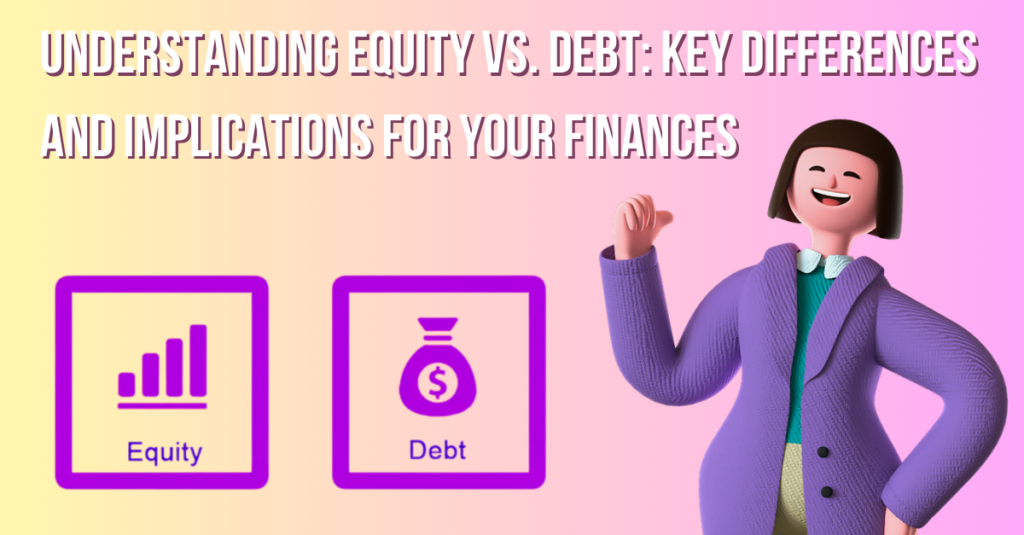Understanding Equity vs. Debt: Key Differences and Implications for Your Finances
Introduction
I. Equity Financing

Equity financing involves raising capital by selling ownership stakes in a business. This form of funding provides investors with ownership shares, making them partial owners of the company. There are two primary types of equity: common stock and preferred stock.
A. Definition and Characteristics
- Ownership Stake: When individuals or entities invest in a company through equity, they receive shares that represent a portion of ownership. This ownership stake gives investors certain rights, such as voting on important matters and participating in the company’s profits.
- Dividends: In the case of common stock, investors may receive dividends, which are a portion of the company’s profits distributed to shareholders. Preferred stockholders often receive fixed dividends before common stockholders.
B. Sources of Equity
- Common Stock: This is the most common form of equity, representing basic ownership in a company. Common stockholders have voting rights and may receive dividends, although the latter is not guaranteed.
- Preferred Stock: Preferred stockholders have a higher claim on assets and earnings compared to common stockholders. They typically receive fixed dividends and may have additional voting rights.
C. Advantages of Equity Financing
- No Debt Repayment: Unlike debt financing, equity financing does not require periodic repayments. Investors become shareholders and participate in the company’s success without the pressure of repaying borrowed funds.
- Shared Risk: Equity investors share the risks and rewards of the business. If the company thrives, shareholders benefit from increased stock value and potential dividends. Conversely, if the business faces challenges, investors may experience losses.
D. Disadvantages of Equity Financing
- Dilution of Ownership: As a company issues more shares to raise capital, existing shareholders’ ownership stakes become diluted. This dilution can diminish their influence in decision-making processes.
- Shareholder Expectations: Equity investors may have expectations regarding the company’s performance and growth. Meeting these expectations is crucial to maintaining investor confidence and preventing negative impacts on stock value.
II. Debt Financing

Debt financing involves raising capital by borrowing funds, which must be repaid over time with interest. This method allows businesses to leverage their assets and generate capital without diluting ownership.
A. Definition and Characteristics
- Borrowed Capital: When a business opts for debt financing, it borrows a specific amount from lenders or financial institutions. This borrowed capital must be repaid according to the agreed-upon terms, usually with interest.
- Interest Payments: In addition to repaying the principal amount borrowed, businesses must make interest payments, which represent the cost of borrowing. The interest rate is determined by factors such as the creditworthiness of the borrower and prevailing market conditions.
B. Sources of Debt
- Loans: Businesses can obtain loans from banks or other financial institutions, which are repaid over a specified period with interest.
- Bonds: Companies can issue bonds to raise capital. Bonds are debt securities that investors purchase, effectively lending money to the issuing entity. The company repays the bondholders at a predetermined interest rate over a specific period.
C. Advantages of Debt Financing
- Retained Ownership: Unlike equity financing, debt financing allows businesses to retain full ownership. Lenders do not gain ownership stakes in the company, and shareholders’ influence remains unaffected.
- Tax Benefits: Interest payments on debt are often tax-deductible, providing a financial advantage for businesses utilizing debt financing.
D. Disadvantages of Debt Financing
- Repayment Obligations: Businesses must adhere to strict repayment schedules for both principal and interest. Failure to meet these obligations can lead to financial penalties and damage the company’s credit rating.
- Interest Costs: The cost of borrowing, represented by interest payments, adds to the overall financial burden. High-interest rates or unfavorable loan terms can significantly impact a company’s profitability.
III. Key Differences Between Equity and Debt

A. Ownership Structure
The primary distinction between equity and debt lies in the ownership structure. Equity financing entails selling ownership stakes, resulting in shareholders who have a claim on the company’s assets and profits. In contrast, debt financing involves borrowing funds with the expectation of repayment, allowing the company to maintain full ownership.
B. Repayment Obligations
Equity financing does not impose periodic repayment obligations on the company. Instead, equity investors share in the success or failure of the business. In debt financing, businesses must adhere to a structured repayment plan, including both principal and interest payments.
C. Risk and Return
Equity investors assume a share of the business risk but also enjoy the potential for significant returns if the company prospers. On the other hand, debt financing carries less risk for lenders, as they receive fixed interest payments and the return of the principal amount, regardless of the company’s performance.
D. Impact on Financial Statements
Equity and debt financing have distinct impacts on a company’s financial statements. Equity transactions affect the equity section of the balance sheet, reflecting changes in ownership. Debt transactions, on the other hand, affect both the liability side of the balance sheet and the income statement through interest expenses.
IV. Implications for Your Finances

A. Decision-Making Considerations
- Business Stage and Growth Plans: The stage of your business and its growth plans play a crucial role in determining the most suitable financing option. Startups may find equity financing attractive to fuel initial growth, while more established businesses may opt for a mix of equity and debt to balance capital structure.
- Cost of Capital: Understanding the cost of capital associated with each financing option is essential. While equity financing may not require direct repayment, the potential dilution of ownership and shareholder expectations should be carefully weighed. Debt financing, on the other hand, involves explicit interest costs that impact profitability.
B. Case Studies
- Successful Use of Equity Financing: Explore case studies of businesses that successfully utilized equity financing to fuel growth. Analyze how these companies managed dilution concerns and met shareholder expectations.
- Effective Debt Management: Examine instances where businesses effectively managed debt, balancing repayment obligations with maintaining operational flexibility. Understand the importance of negotiating favorable loan terms and managing interest costs.
C. Balancing Equity and Debt
- Optimal Capital Structure: Striking the right balance between equity and debt is crucial for maintaining an optimal capital structure. Assess your company’s financial goals, risk tolerance, and growth plans to determine the appropriate mix.
- Flexibility and Adaptability: Financial landscapes evolve, and businesses must remain flexible in adapting their financing strategies. Evaluate the ongoing suitability of your chosen financing methods and be prepared to adjust as circumstances change.
Conclusion (Understanding Equity vs. Debt: Key Differences and Implications for Your Finances)

My name is Rohit Vagh and I’m a content writer specializing in fashion and lifestyle. I have three years of experience in this field and have written various articles. My writing style is creative and engaging, and I strive to create content that resonates with my readers. I have a deep passion for fashion and am constantly researching the latest trends and styles to make sure my readers are up to date. I’m excited to continue my career in blogging, and I’m always looking for new opportunities in the fashion and lifestyle space.





